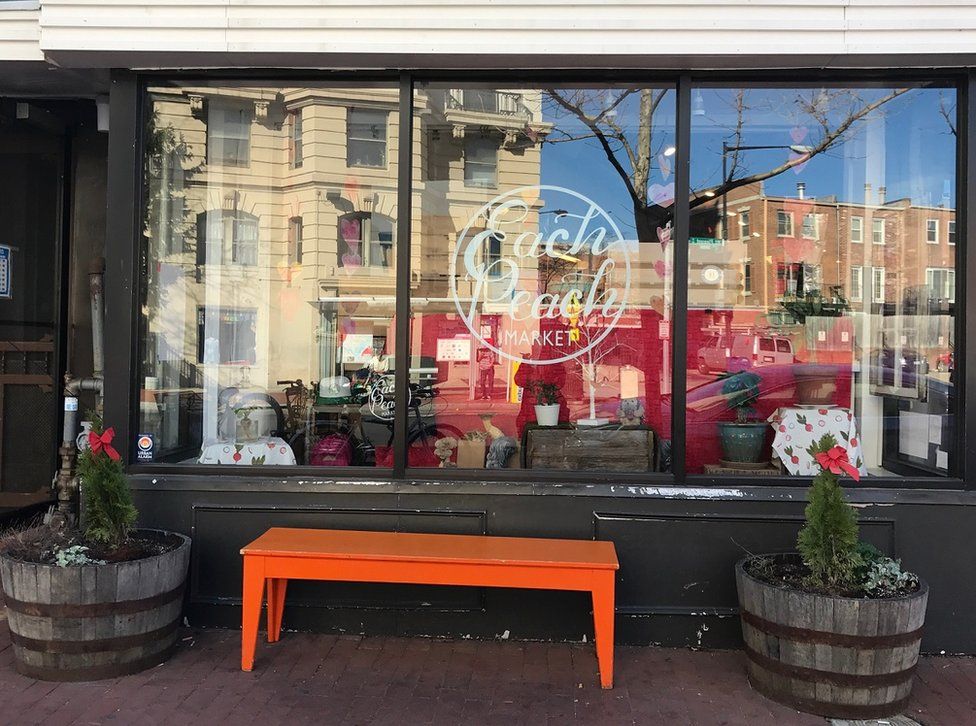'Street seats' aim to revolutionise cities through sitting
- Published

Planners hope more benches in urban centres will help build friendlier cities.
When it opened, Each Peach Market, an independent grocery store in Washington DC, put up a black bench taken from co-founder Emily Friedburg's home.
After months of weather and frequent use, the bench lost an armrest and eventually buckled. Neglecting to replace the seat wasn't an option. In its place, a bright orange, weather-proofed bench now stands outside of the market's large storefront windows.
"We are really entrenched in the community and this bench feels like an offshoot of that," Friedburg said.
The store doesn't have seating inside, so people often sit down to eat a sandwich they purchased inside. The bench also attracts students and people grabbing Chinese takeaway from the restaurant next door, she added.
Eleanor Gease, the store's general manager, said that the bench helps foster the feeling that the store is there to serve the community. "It's nice to have a spot where people can sit and enjoy the breeze. People just hang out to have a rest."
Cities across the nation are encouraging businesses and community organisations to install seats along sidewalks.
It's part of a design movement called tactical urbanism, meant to make city living more comfortable and enjoyable, said Mike Lydon, who heads the urban planning and design firm Street Plans.
"It's a bottom-up process," Lydon says. "A lot of the work can be started by businesses and then taken over by cities."
Advocates say tactical urbanism creates cities that can adapt to challenges easily. Temporary and cheap options like street seats allow communities to put up, move and take down public spaces as needed.
Street seats are often inspired by a lack of indoor seating, like at Each Peach Market, or by a desire to create a sense of community in an otherwise transient stretch of road.
"American cities have an excess of roadway space," says Anastasia Loukaitou-Sideris, an urban planning professor at the University of California, Los Angeles. The street seats movement aims to reclaim some of that road for the pedestrian.
The seats "make public space more vibrant," Loukaitou-Sideris added.
"They bring in more people, which improves business."
Tactical urbanism doesn't stop at street seats. The fancier cousin of the seats is the parklet, miniature parks that take up a parking space or two.
In Washington, DC, the annual Park(ing) Day celebration, in which businesses and community organisers build temporary parks in metered parking spots, inspired a program to allow permanent parklets to be installed in approved spots along the District's streets.
Inside these new parklets, businesses put out benches and chairs for their customers and the public to use whenever tired feet need a rest.
One seasonal parklet in downtown Washington has reinvented itself each year, erecting a new geometric and neon bench decorated with annual flowers. The seats show up when the weather warms in the spring and disappear when the winter chill sets in.
New York City has two programmes designed to promote public seating with the aim to make the city "more comfortable for transit riders and pedestrians, especially for those who are older and disabled," according to the city's website.
New York City's Department of Transportation will reimburse businesses who decide to install public street seats. It also runs a programme called "CityBench" that has erected 1,500 benches and aims to add another 600 by 2019.
In west coast cities like San Francisco and Los Angeles, the weather allows for year-round street seats. Portland runs a "street seat" programme that has inspired eclectic designs - from benches that look like giant lawn chairs to seats that double as planters reminiscent of grassy hillsides.
"Community engagement, that's what made them really popular and really fun," said Leah Treat, director for the Portland Bureau of Transportation.
The city's 14 street seats are part of Portland's goal to create "20-minute neighbourhoods" where residents can get to everything they need within a short walk.
"There's a great culture here in Portland of embracing streets as public space," Treat said. "People can express the sort of distinct characteristics of the neighbourhood where (the seats) are. Each one is really different."
In Portland's east side industrial district, for example, the street seat has aluminium siding that reflects the buildings around it. Near the Alberta Art District, the seats incorporate a "very funky" and "visually beautiful" architectural design, Treat added.
"They're largely popular because you can get outside," Treat says. "It's really nice. You can hang out with your friends and eat outside."
On warm, sunny days in Washington DC, the bench in front of Each Peach Market has a rotating cast of sitters, from high school students sipping sodas to neighbourhood workers taking smoke breaks.
"It's a great way to be part of the neighbourhood," Gease said as she perched on the edge of the tangerine seat. "It feels like an intimate space."